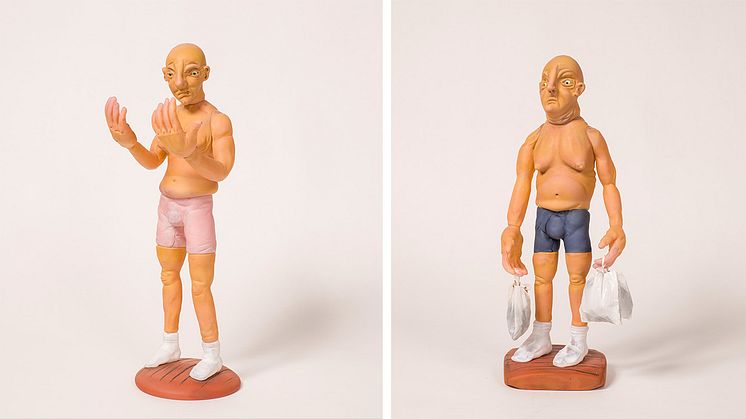
Press release -
Nationalmuseum acquires two glass sculptures by Rasmus Nossbring
Nationalmuseum has acquired two glass sculptures by Rasmus Nossbring. They are part of a group of five, comprising Nossbring’s degree project at Konstfack in 2017. The glass sculptures are portraits of his former colleagues at Reijmyre Glassworks, capturing the everyday private moments in which the person is the most vulnerable.
Rasmus Nossbring (b. 1991) started his career as a school-weary 15-year-old with a work placement as a glassblower at Reijmyre Glassworks, where he was introduced to various glassmaking techniques by the older and more experienced glassblowers. When Nossbring graduated from Konstfack in 2017, his Bachelor’s degree project, called Those who wait, consisted of five glass sculptures depicting his former colleagues at the glassworks. The theme is how manual labour, strict working hours and humdrum routines can contribute to obsessive behaviours when it comes to toilet visits, arrival times, placement of tools and coffee breaks. Nossbring’s question concerned life outside of the workplace. When work is so strictly regulated, what do you do in your spare time? Wait to go to work?
"Nossbring says that he wants to capture glimpses of vulnerability in everyday life with these glass sculptures. When we are absolutely alone, we all do things that we would never do with, or even admit to anyone else. These are often activities involving the body, such as eating butter with a spoon right out of the package, picking navel lint or scratching your bottom. Situations that most people would find embarrassing, as they show us without the mask of civilisation. This is the type of unglamorous situation that Nossbring wants to capture, visualise and discuss," says Cilla Robach, curator specialising in applied art and design at Nationalmuseum.
The men depicted in the glass sculptures are performing various everyday activities. The title of each sculpture specifies the time of day when the activity is usually carried out. The situations are clearly private; the men are naked or half-naked. The bodies reveal the day to day of the working class. These are not muscular bodies flexing on display, but the bodies of ordinary older men, shaped by hard labour. The material is glass, shaped through a technique that Nossbring developed himself. He freely sculpts the hot glass, shaping the various body parts using tongs and other tools. The colour is applied in three layers while the glass is still warm. When the body parts have cooled down, Nossbring tests how they look together. Once assembled, the figurine is sandblasted, giving it a relatively matt, satin-like surface, which is not usually associated with glass.
Nationalmuseum’s collections now include 16.04 (most calluses wins) and 19.43 (two birds, one stone). The first depicts a man in his underpants and socks, looking at his callused hands. The man was always the first in and out of the shower after a shift. While air drying, he would massage his hands, which were full of calluses after working his whole life in the glass industry. He liked to show them off and sometimes, his fists looked more like bark than hands,something that he was enormously proud of. As he was standing there massaging his hands, you could tell that the heavy work had also taken its toll. 19.43 shows a man in his underpants heading out with three bin bags. He could think of nothing worse than unnecessary work, and so he would routinely save up his bin bags until it was worth to take them out. Three bags was considered the optimal number, then he could open the door without putting the bags down, and the smell had usually not gotten too bad yet. Despite the exposed nature of these situations, the depictions are both warm and loving.
Nationalmuseum receives no state funds with which to acquire design, applied art and artwork; instead the collections are enriched through donations and gifts from private foundations and trusts. This acquisition was made possible thanks to a donation by Fredrik Posse through Nationalmusei Vänner.
Inventory number:
Rasmus Nossbring, Sculpture, 16.04, (most calluses win), 2017.Glass sculpted by hand, coloured and blasted. NMK 120/2019.
Rasmus Nossbring,Sculpture, 19.43, (two birds, one stone), 2017. Glass sculpted by hand, coloured and blasted. Miniatures of waste: plastic, paper, metal, glue, acrylic paint, polymer clay. NMK 121/2019.
For more information
Cilla Robach, curator applied art and design, cilla.robach@nationalmuseum.se, +46 (0)8 5195 4305
Hanna Tottmar, press officer, press@nationalmuseum.se, +46 (0)8 5195 4400
Categories
Nationalmuseum is Sweden’s museum of art and design. The collections include paintings, sculpture, drawings and graphic art from the 16th century up to the beginning of the 20th century and the collection of applied art and design up to the present day. The museum building closed for renovation in 2013 and reopened in autumn 2018. During 2019 the museum had almost 850 000 visits.

